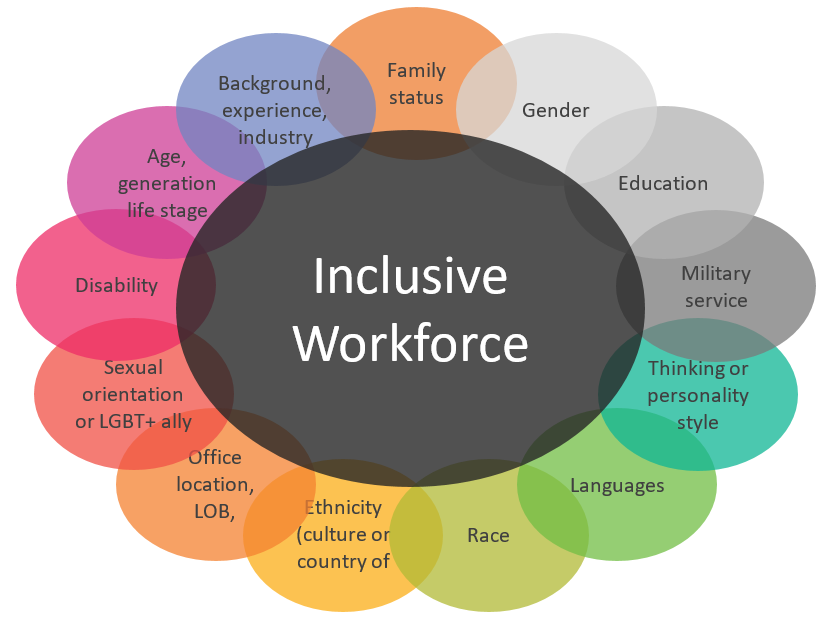
Diversity and Inclusion Programs: Creating a Diverse and Inclusive Workplace – Your Essential Guide
In today’s fast-paced world, businesses are realizing something incredibly powerful: a successful team isn’t just about individual talent, but about the rich tapestry of backgrounds, ideas, and experiences that everyone brings. This is where Diversity and Inclusion (D&I) programs come into play.
If you’re new to the concept, or looking to strengthen your workplace culture, you’ve come to the right place. This article will break down what D&I means, why it’s crucial for every organization, and how to build effective programs that truly make a difference.
What Exactly Are Diversity and Inclusion? Let’s Break It Down.
Before we dive into programs, it’s essential to understand the two core concepts:
1. Diversity: The Mix
Think of diversity as all the different characteristics that make people unique. It’s about recognizing and valuing these differences. It goes far beyond just race or gender.
Diversity includes, but is not limited to:
- Race and Ethnicity: Different cultural backgrounds and heritages.
- Gender Identity and Expression: Male, female, non-binary, transgender, cisgender.
- Sexual Orientation: LGBTQ+ identities.
- Age: Different generations working together (Gen Z, Millennials, Gen X, Baby Boomers).
- Abilities: People with different physical, cognitive, and sensory abilities.
- Religion and Beliefs: Various spiritual and philosophical perspectives.
- Socioeconomic Background: Different life experiences shaped by economic circumstances.
- Education: Diverse educational paths and institutions.
- Nationality and Geographic Origin: People from various countries and regions.
- Thought and Perspective: Different ways of thinking, problem-solving, and approaching tasks (cognitive diversity).
In simple terms: Diversity is about having a wide variety of people at the table.
2. Inclusion: Making the Mix Work
Inclusion is the act of creating an environment where everyone feels welcome, valued, respected, and heard. It’s about making sure all those diverse voices can speak up and are genuinely listened to.
An inclusive workplace means:
- Belonging: People feel like they truly fit in and are part of the team.
- Psychological Safety: Employees feel safe to express ideas, ask questions, and make mistakes without fear of negative consequences.
- Fairness: Processes, policies, and opportunities are equitable and transparent for everyone.
- Respect: Every individual’s unique contributions and perspectives are acknowledged and appreciated.
- Voice: People feel empowered to share their thoughts, concerns, and ideas, and know they will be considered.
In simple terms: Inclusion is about making sure everyone at the table feels comfortable, has a voice, and knows their contribution matters.
Why you need BOTH: You can have a diverse workforce (different people at the table), but without inclusion, those diverse voices might not feel comfortable speaking up or contributing their best. It’s like having all the ingredients for a cake (diversity) but no oven to bake it in (inclusion). Both are crucial for success!
Why Diversity and Inclusion Programs Are Essential for Your Business
D&I isn’t just a "nice-to-have" or a box to tick. It’s a strategic imperative that brings tangible benefits to your bottom line and your workplace culture.
1. Boosts Innovation and Creativity
- More Ideas: Diverse teams bring a wider range of experiences and perspectives, leading to more unique ideas and solutions.
- Better Problem-Solving: When people approach problems from different angles, they uncover blind spots and develop more robust solutions.
- Reduced Groupthink: Homogeneous teams often fall into "groupthink," where everyone thinks alike. Diversity challenges this, leading to more critical thinking.
2. Attracts and Retains Top Talent
- Employer of Choice: Companies with strong D&I initiatives are more attractive to job seekers, especially younger generations who prioritize inclusive workplaces.
- Lower Turnover: When employees feel valued, respected, and included, they are more likely to stay with the company long-term. This saves money on recruitment and training.
- Wider Talent Pool: By actively seeking diversity, you broaden your search for talent, tapping into previously overlooked groups.
3. Enhances Employee Engagement and Morale
- Increased Job Satisfaction: Employees who feel a sense of belonging and fairness are happier and more engaged in their work.
- Stronger Team Cohesion: When differences are celebrated, it builds empathy and understanding among team members.
- Higher Productivity: Engaged employees are more productive and committed to the company’s success.
4. Improves Financial Performance
- Increased Revenue: Studies by organizations like McKinsey & Company and Deloitte consistently show that diverse companies outperform their less diverse counterparts financially.
- Better Decision-Making: Diverse teams make better, more informed decisions, which leads to better business outcomes.
- Stronger Market Understanding: A diverse workforce can better understand and serve a diverse customer base, leading to new market opportunities.
5. Strengthens Company Reputation
- Positive Brand Image: Companies known for their D&I efforts are viewed positively by customers, partners, and the wider community.
- Customer Loyalty: Customers are increasingly choosing to support businesses that align with their values, including diversity and inclusion.
- Social Responsibility: Demonstrating a commitment to D&I shows your company cares about social equity and fair treatment for all.
Key Components of Effective Diversity and Inclusion Programs
Building a successful D&I program isn’t a one-time event; it’s an ongoing journey. Here are the foundational elements:
1. Strong Leadership Commitment and Buy-in
- Top-Down Support: D&I must be championed by senior leadership. Without their visible support and investment, initiatives often fail.
- Role Modeling: Leaders should exemplify inclusive behaviors and actively participate in D&I initiatives.
- Accountability: Leaders should be held accountable for D&I goals, just like any other business objective.
2. Data Collection and Assessment
- Understand Your Starting Point: Collect anonymous data on your current workforce demographics (gender, age, ethnicity, etc.) and employee perceptions of inclusion (through surveys).
- Identify Gaps: This data helps you understand where you have diversity gaps and where employees feel less included.
- Measure Progress: Regular data collection allows you to track the effectiveness of your D&I initiatives over time.
3. Clear Goals and Metrics
- Specific, Measurable Goals: Don’t just say "we want to be more diverse." Set concrete goals, e.g., "Increase representation of women in leadership by 15% in two years."
- Key Performance Indicators (KPIs): Track metrics like retention rates for diverse groups, promotion rates, participation in D&I programs, and results from inclusion surveys.
- Transparency: Share progress (or lack thereof) with employees to foster trust and demonstrate commitment.
Practical Steps: Creating a Diverse and Inclusive Workplace
Now, let’s get into the actionable steps you can take to implement effective D&I programs.
1. Inclusive Hiring Practices
This is where diversity begins. It’s about intentionally removing barriers and biases from your recruitment process.
- Blind Resume Reviews: Remove identifying information (names, photos, addresses, graduation years) from resumes to reduce unconscious bias.
- Diverse Interview Panels: Ensure your interviewers represent different backgrounds to offer varied perspectives and make candidates feel more comfortable.
- Standardized Interviews: Ask the same questions to all candidates and use a clear scoring rubric to ensure fairness and reduce subjectivity.
- Skill-Based Assessments: Focus on practical skills relevant to the job rather than relying solely on traditional qualifications or past experience.
- Inclusive Job Descriptions: Use gender-neutral language and avoid jargon. Emphasize desired skills and competencies rather than specific degrees or years of experience.
- Broaden Sourcing: Look beyond traditional recruitment channels. Partner with diverse professional organizations, community groups, and educational institutions.
2. Unconscious Bias Training
Everyone has unconscious biases – automatic mental shortcuts that can influence our decisions without us even knowing it. Training helps employees recognize and mitigate these biases.
- What it Covers: Explains what unconscious bias is, common types (e.g., affinity bias, confirmation bias), and how it impacts workplace decisions.
- Practical Strategies: Provides tools and techniques to challenge biases in hiring, performance reviews, promotions, and everyday interactions.
- Regular and Ongoing: This shouldn’t be a one-off session. Regular refreshers and deeper dives into specific biases are more effective.
3. Employee Resource Groups (ERGs) / Business Resource Groups (BRGs)
ERGs are voluntary, employee-led groups formed around shared characteristics or life experiences. They are powerful tools for fostering inclusion.
- Purpose: Provide support, networking opportunities, and a sense of community for employees with shared identities (e.g., Women in Tech, LGBTQ+ Alliance, Veterans Group, Parents Network).
- Business Impact: ERGs can also serve as valuable resources for the business, offering insights on product development, marketing strategies, and cultural understanding.
- Leadership Support: Provide funding, meeting spaces, and executive sponsorship to help ERGs thrive.
4. Mentorship and Sponsorship Programs
These programs are crucial for career development and ensuring diverse talent advances within the organization.
- Mentorship: Experienced employees provide guidance, advice, and support to less experienced colleagues.
- Sponsorship: Senior leaders actively advocate for and champion the careers of high-potential employees, especially those from underrepresented groups, helping them gain visibility and opportunities.
- Cross-Cultural Mentoring: Encourage mentoring relationships between individuals from different backgrounds to foster understanding and break down silos.
5. Inclusive Communication and Language
Words matter. How we communicate can either build bridges or create barriers.
- Gender-Neutral Language: Use "they/them" or "people" instead of assuming gender.
- Person-First Language: Focus on the person, not the disability (e.g., "person with a disability" instead of "disabled person").
- Avoid Stereotypes and Jargon: Be mindful of language that could perpetuate stereotypes or exclude those unfamiliar with industry-specific terms.
- Actively Listen: Encourage active listening to ensure all voices are heard and understood, not just acknowledged.
- Inclusive Meetings: Set clear agendas, ensure everyone has a chance to speak, and avoid interruptions. Consider rotating who facilitates meetings.
6. Flexible Work Arrangements
Offering flexibility can significantly enhance inclusion, allowing employees to better balance work and personal life.
- Remote Work Options: Allows people from diverse locations or with specific needs (e.g., caregivers) to participate.
- Flexible Hours: Accommodates different schedules, time zones, and personal commitments.
- Compressed Workweeks: Offering options like 4×10-hour days.
- Part-Time Options: Providing opportunities for those who can’t commit to full-time work.
7. Continuous Feedback and Learning
D&I is an evolving field. A commitment to ongoing learning and improvement is vital.
- Regular Inclusion Surveys: Conduct surveys to gauge employee perceptions of fairness, belonging, and respect.
- Anonymous Feedback Channels: Provide safe ways for employees to report concerns or offer suggestions related to D&I.
- Learning Resources: Offer a library of books, articles, and videos on D&I topics.
- D&I Committees: Establish a dedicated committee with diverse representation to guide and champion initiatives.
8. Celebrating Differences and Inclusive Events
- Cultural Celebrations: Acknowledge and celebrate diverse holidays and cultural events.
- Heritage Months: Recognize and educate the workforce about heritage months (e.g., Black History Month, Women’s History Month, Pride Month).
- Storytelling: Encourage employees to share their personal stories and experiences (voluntarily) to build empathy and understanding.
- Inclusive Social Events: Plan events that cater to diverse interests and needs, considering things like accessibility, dietary restrictions, and alcohol-free options.
Overcoming Challenges in D&I Implementation
Even with the best intentions, implementing D&I programs can face hurdles.
- Resistance to Change: Some employees might resist D&I initiatives due to fear of the unknown, discomfort with discussing sensitive topics, or a feeling that D&I is "not for them."
- Solution: Emphasize the benefits for everyone, provide clear communication, and address concerns openly and empathetically.
- Tokenism: This occurs when a company hires or promotes a few diverse individuals simply to meet quotas, without genuine inclusion or support.
- Solution: Focus on systemic change, not just numbers. Ensure diverse hires are supported, mentored, and given real opportunities to contribute and advance.
- Lack of Sustained Effort: D&I is a marathon, not a sprint. Initial enthusiasm can wane if not continuously nurtured.
- Solution: Integrate D&I into core business strategies, assign dedicated resources, and regularly review progress against clear goals.
- Fear of "Getting It Wrong": Employees and leaders might hesitate to engage for fear of saying or doing the wrong thing.
- Solution: Foster a culture of learning and psychological safety. Encourage open dialogue, admit mistakes, and provide resources for continuous education.
Conclusion: Diversity and Inclusion as a Journey, Not a Destination
Creating a truly diverse and inclusive workplace is a continuous journey of learning, adapting, and growing. It’s about building a culture where every individual feels respected, valued, and empowered to bring their whole, authentic self to work.
By investing in robust Diversity and Inclusion programs, you’re not just doing the right thing; you’re building a stronger, more innovative, and more resilient organization ready to thrive in the modern world. Start small, be patient, stay committed, and watch your workplace transform into a vibrant hub of talent and collaboration.
SEO Keywords: Diversity and Inclusion Programs, D&I, workplace diversity, inclusive workplace, inclusive culture, employee resource groups, unconscious bias training, inclusive hiring, benefits of diversity, creating an inclusive environment, HR diversity, talent management, employee engagement, diversity initiatives.



Post Comment